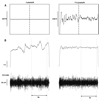Greater amount of visual feedback decreases force variability by reducing force oscillations from 0-1 and 3-7 Hz
- PMID: 19953262
- PMCID: PMC2863099
- DOI: 10.1007/s00421-009-1301-5
Greater amount of visual feedback decreases force variability by reducing force oscillations from 0-1 and 3-7 Hz
Abstract
The purpose was to determine the relation between visual feedback gain and variability in force and whether visual gain-induced changes in force variability were associated with frequency-specific force oscillations and changes in the neural activation of the agonist muscle. Fourteen young adults (19-29 years) were instructed to accurately match the target force at 2 and 10% of their maximal voluntary contraction with abduction of the index finger. Force was maintained at specific visual feedback gain levels that varied across trials. Each trial lasted 20 s and the amount of visual feedback was varied by changing the visual gain from 0.5 to 1,474 pixels/N (13 levels; equals approximately 0.001-4.57 degrees ). Force variability was quantified as the standard deviation of the detrended force data. The neural activation of the first dorsal interosseus (FDI) was measured with surface electromyography. The mean force did not vary significantly with the amount of visual feedback. In contrast, force variability decreased from low gains compared to moderate gains (0.5-4 pixels/N: 0.09 +/- 0.04 vs. 64-1,424 pixels/N: 0.06 +/- 0.02 N). The decrease in variability was predicted by a decrease in the power of force oscillations from 0-1 Hz (approximately 50%) and 3-7 Hz (approximately 20%). The activity of the FDI muscle did not vary across the visual feedback gains. These findings demonstrate that in young adults force variability can be decreased with increased visual feedback gain (>64 pixels/N vs. 0.5-4 pixels/N) due to a decrease in the power of oscillations in the force from 0-1 and 3-7 Hz.
Figures






References
-
- Brown P. Cortical drives to human muscle: the Piper and related rhythms. Prog Neurobiol. 2000;60:97–108. - PubMed
-
- Chao EYS, An KN, Cooney WP, Linschied RL. Biomechanics of the hand. A basic research study. Teaneck: World Scientific Publishing; 1989.
-
- Christou EA. Visual feedback attenuates force fluctuations induced by a stressor. Med Sci Sports Exerc. 2005;37:2126–2133. - PubMed
Publication types
MeSH terms
Grants and funding
LinkOut - more resources
Full Text Sources

